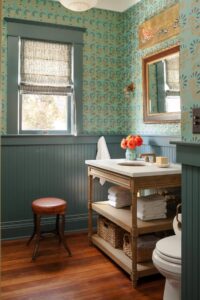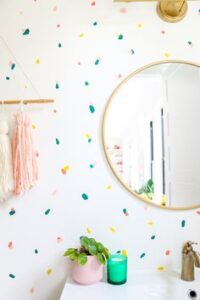Pain over wallpaper has its advantages; in theory, it eliminates the time-consuming, dirty, and occasionally irritating procedure of removing wall coverings to get freshly painted walls. However, for individuals concerned about the endurance and quality of their painting endeavor, it’s critical to confirm that it’s safe to paint over that mauve chintz acquired from the previous owners.
To get to the bottom of it, we spoke with Terry Koubele, Owner of Five Star Painting, who revealed that it is possible to properly paint over wallpaper. However, it may be wiser to think of it as a backup plan rather than a first choice.
Is Wallpaper Coverable with Paint?
The answer to the issue of whether you can paint over wallpaper is yes, but the question of whether you should is no. The latter question depends on the other variables at work. “It makes sense to paint over old wallpaper if the removal costs are too expensive or if removing it would damage the condition of the walls,” claims Koubele. In certain situations, moving on is possible without first deleting the wallpaper. However, to do so successfully, you’ll need to take specific preparatory measures to make sure your walls are smooth and prepared for priming and painting.
When Should You Not Paint Over Wallpaper?

There are times when painting over wallpaper is absolutely necessary. Painting over wallpaper to smooth out a rough surface is at the top of the no-no list. When it comes to covering up textured wallpaper, no amount of paint will suffice.
Another scenario that you should avoid attempting to repair with paint is damaged wallpaper. Those flaws, lumps, bubbles, and tears will still be apparent after painting. In such circumstances, removing the paper is the only option.
Getting Wallpapered Walls Ready for Painting
If you determine that painting over your wallpaper is a viable choice, there are several steps you should do before getting out the paint rollers. The first step is to ensure that the seams are securely attached to the walls. “Paint and primer that finds its way underneath can make the edges look even worse,” Koubele explains. The same is true for any loose ends.
You should also clean the wallpaper with a dry duster or towel to achieve the smoothest surface. Using a damp or wet cloth for this stage could harm the wallpaper and your ability to paint it efficiently.
Painting Wallpapered Walls
Koubele provides a step-by-step method for painting over wallpaper.
Step 1: Tape Off the Room and Check for Safety:
Because you’ll be using an oil-based primer, you’ll want to take extra steps to ensure sufficient ventilation after taping off the baseboards, ceiling, and moldings with painters tape. Open any windows or doors and wear a N95 mask to ventilate the painting area. To fully hold the paint, you’ll additionally require to use a brush built exclusively for oils.
Step 2: Use an oil-based primer:
An oil-based primer seals any old glue from the wallpaper, preventing future problems. A tinted-gray primer is great for darker colors since it makes the finish stand out more.
Step 3: Apply Wallpaper:
It’s time to paint after the primer has cured overnight. It is acceptable to apply latex paint over the oil-based primer; simply select a paint finish with a low sheen, such as satin. A high shine can draw attention to flaws or texture in wallpaper.
Begin with an angled brush on the ceiling, then roll the rest of the wall in a “W” shape. Cross your fingers to cover the entire wall. Because a vertical approach leaves lines as the paint builds up on the roller, the “W” form is ideal. When you may apply the second coat, follow the drying instructions on the paint can.
Other Options for Painting Over Wallpaper
Painting over wallpaper is not recommended in some instances, but it doesn’t mean you have to pay for expensive removal or do it yourself. Covering up unattractive wallpaper is one of the quickest and easiest ways to remove it.
Tapestry
Large tapestries or wall hangings are one of the simplest ways to cover up your wallpaper without undergoing a significant renovation.It can not only conceal the wallpaper you’re attempting to remove, but it can also give texture, interest, and a new focal point to the area.
Art
Maximalist art, in particular, can be an efficient technique to limit the amount of wallpaper in your room. While art, portraits, and other large-scale wall decor will not cover over wallpaper from floor to ceiling, they will assist distract the focus away from the wallpaper you’re attempting to conceal.
Faux Shiplap
A full wallcovering, such as shiplap, can entirely conceal your wallpaper problem without the need for prior repair or priming.It can also be installed from floor to ceiling, hiding every inch of your existing wall coverings.
Frequently Asked Questions
What is the best paint to use while painting wallpaper?
Over the oil-based primer, latex paint can be utilized. Oil-based paint is also an excellent choice.
Is it necessary to prime wallpaper before painting it?
Yes, an oil-based primer should be used to prepare the walls. This form of primer seals in any old glue from the paper and prevents paint failure in the future.
Is it necessary to fix wallpaper before painting it?
Any loose ends must be glued down, and the seam must be mudded, sanded, and textured as needed.There is no need to remove anything; simply tighten any loose ends and seams so that the entire surface area is smooth.
Is it possible to glue down peeling wallpaper ends?
Yes, because paint and primer that gets below loose ends can make them appear even worse.





Fantastic web site. Plenty of useful info here.
I am sending it to some pals ans also sharing in delicious.
And of course, thank you in your sweat!